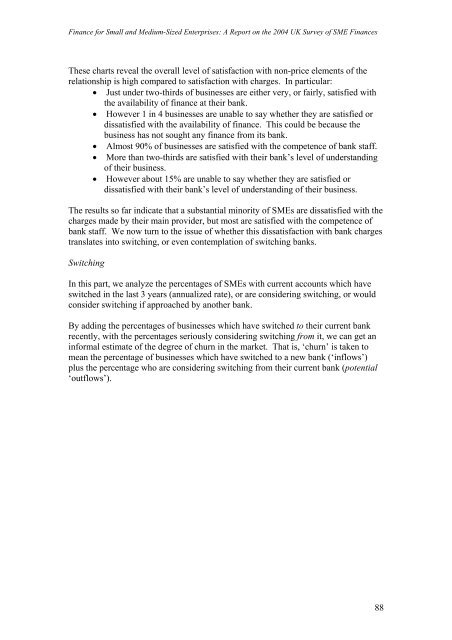Finance for Small and Medium-Sized Enterprises - DTI Home Page
Finance for Small and Medium-Sized Enterprises - DTI Home Page
Finance for Small and Medium-Sized Enterprises - DTI Home Page
You also want an ePaper? Increase the reach of your titles
YUMPU automatically turns print PDFs into web optimized ePapers that Google loves.
<strong>Finance</strong> <strong>for</strong> <strong>Small</strong> <strong>and</strong> <strong>Medium</strong>-<strong>Sized</strong> <strong>Enterprises</strong>: A Report on the 2004 UK Survey of SME <strong>Finance</strong>s<br />
These charts reveal the overall level of satisfaction with non-price elements of the<br />
relationship is high compared to satisfaction with charges. In particular:<br />
• Just under two-thirds of businesses are either very, or fairly, satisfied with<br />
the availability of finance at their bank.<br />
• However 1 in 4 businesses are unable to say whether they are satisfied or<br />
dissatisfied with the availability of finance. This could be because the<br />
business has not sought any finance from its bank.<br />
• Almost 90% of businesses are satisfied with the competence of bank staff.<br />
• More than two-thirds are satisfied with their bank’s level of underst<strong>and</strong>ing<br />
of their business.<br />
• However about 15% are unable to say whether they are satisfied or<br />
dissatisfied with their bank’s level of underst<strong>and</strong>ing of their business.<br />
The results so far indicate that a substantial minority of SMEs are dissatisfied with the<br />
charges made by their main provider, but most are satisfied with the competence of<br />
bank staff. We now turn to the issue of whether this dissatisfaction with bank charges<br />
translates into switching, or even contemplation of switching banks.<br />
Switching<br />
In this part, we analyze the percentages of SMEs with current accounts which have<br />
switched in the last 3 years (annualized rate), or are considering switching, or would<br />
consider switching if approached by another bank.<br />
By<br />
adding the percentages of businesses which have switched to their current bank<br />
recently, with the percentages seriously considering switching from it, we can<br />
get an<br />
in<strong>for</strong>mal<br />
estimate of the degree of churn in the market. That is, ‘churn’ is taken to<br />
mean the percentage of businesses which have switched to a new bank (‘inflows’)<br />
plus the percentage who are considering switching from their current bank (potential<br />
‘outflow s’).<br />
88















![Joint Report on Social Protection and Social Inclusion [2005]](https://img.yumpu.com/19580638/1/190x132/joint-report-on-social-protection-and-social-inclusion-2005.jpg?quality=85)
